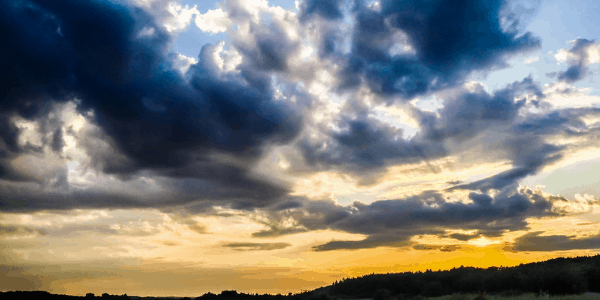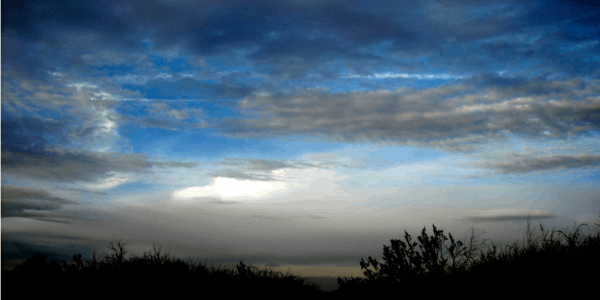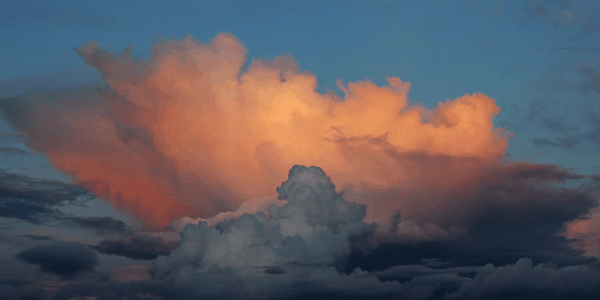
Recently I wrote an article about weather witching — when a witch incorporates weather magick into their Craft — and was so fascinated by the subject that I moved onto learning other, older ways of weather working when I found all I could about weather witching.
Related: Weather witching: Harnessing the power of weather magick, by MagicalMusingsWitchyWriter
Druidry and shamanism are quite similar, as they are both Pagan spiritualities characterized by animism (the belief that everything and everyone has a spirit –- the trees, rocks, the computer I’m clicking away on right now — you get the idea), a reverence for nature, a polytheistic approach (for many anyway, some identify as atheist or otherwise), and both practices rely heavily on the ability to visualize. They understand that the human imagination is a powerful tool with the capability of creating a whole new realm (i.e. a Druid’s inner grove), and the ability to take your soul to other worlds (referred to as a soul journey).
The age of Enlightenment almost destroyed the shamanism of our ancestors, but there was enough left to become the basis for witchcraft, Druidry and non-tribal shamanism when they were revived in the 1950s. This explains why these three practices bear such strong resemblances to each other. However, witchcraft and shamanic practices differ when it comes to magick in terms of methodology — hence why I separated “weather witching” from shamanic weather magick.
Weather shamanism
Shamanism is the precursor of all our religious and spiritual traditions, existing in almost every culture since the dawn of civilization. While the specifics of shamanic practice may vary based on culture, the core aspects of shamanism are consistent. According to Dr. Hank Wesselman, “All true shamans are distinguished by their ability to achieve visionary states of consciousness in which they can redirect their focused awareness away from everyday physical reality and into the hidden, inner worlds, all while very much awake.”1
The hidden worlds that shamans travel to are inhabited by spirits: spirits of nature, ancestral spirits, elementals, Fair Folk, angelic forces who serve humanity as guardians, helpers, teachers, guides, etc. Shamans build relationships with spirits of these hidden worlds and spend a great deal of time nurturing and strengthening these relationships.
Nan Moss and Dave Corbin of “Shamanism and Weather Spirits” explain that weather-working shows that the shaman has a strong relationship with the spirits and forces of nature, as weather magick relies on harmonious relationships with weather spirits. Nan and Dave explain that “As with any shamanic healing work, shamans must defer to spiritual forces, knowing that acts of relating and attempts to engage or influence may or may not have any identifiable effect. All they can do is uphold their part in the relationship, respecting the mystery, and let the spirits do the rest.”2
Weather working by way of Spirit
Nan and David explain that forging and maintaining a relationship with the spirits of weather “is to walk on a path of spiritual learning and experience that helps us relate to our sense of connection with all of Nature. In doing so, we can heal the rending wound of disconnection with Nature from which most of us in the modern world suffer.”3

A shaman’s journey to meet with a weather spirit
The shaman, Nan Moss, thrummed on her drum, leading a class with her partner, David Corbin, into a journey to meet weather spirits — each shaman setting out with their own question for the spirits of the sky. The drummer felt desire stir and indicated to her partner that she too would be journeying. She closed her eyes and drummed until her spirit was travelling to the Upperworld with several of her power animals. Up they flew, through storm clouds, searching for a Spirit of Weather. The Spirit was a “cloud being” — a great giant Spirit — “with lightning shining in his eyes, and when he speaks, snowballs tumble from his mouth.”
Nan is grateful to be with her power animals, for they make sure she comes to no harm, while she introduces herself and asks the “imposingly large” cloud spirit for a lesson she can bring back to her community. To her astonishment, the cloud spirit is irate that this human has the audacity to come to him for words of wisdom. The cloud told Nan “that our culture has essentially forgotten him; that in times past, people all over the world spoke to, prayed to, and worked with him. Now he is ignored. Now, our science and ‘knowledge’ attempt to depersonalize and de-spirit him. So he creates aberrant, rough weather to get us to take notice…to know that we do not know.” The shaman offers thanks, and returns, back through the clouds, to the surface of the Upperworld, and back to her body, feeling ashamed. Nan writes((Ibid.)):
I had been participating in the collective cultural arrogance that leaves little room to see, hear, or feel spirits of weather. The extravagant concepts of rainmaking or weather-working were considered taboo by me, elusive in a realm betwixt and between myth and that which is too complicated and too dangerous.
When it comes to weather shamanism, the aim is not to alter the weather, but understand it. The first step is to understand is that the weather is as creative as it is destructive. While we may only see a hurricane or tornado, the weather spirits may have a reason behind sending the weather that we cannot comprehend. The second aspect is to understand that weather is nature, and to build relationships with weather spirits entails connecting with nature on a deeper level.
Nan and David spent years learning, watching, and consulting their spirit guides before starting their practice of weather shamanism. They explained that the approach is a spiritual journey, not an endeavour to conquer the weather.4
Druid magick
Learning about how Druids perform weather magick was tricky, because no matter how explicitly the resource explained the philosophies and theories behind Druid magick, there were no instructions or guidelines for a basic working that applies to Druids as a whole (there are several Druidic orders or traditions, and each with their own unique styles, philosophies, and practices.)
I thought I must have missed it somehow, so I went back to my altar room and gathered all my books on Druidry. Thankfully, I found what I needed in the first book I checked: The Path of Druidry by Penny Billington. Billington explains that no clear instructions are offered because “Druid magic is of the time, the place, the person, the situation, so it’s impossible to give a template.”5
She provided an example from a magical journal containing a range of possibilities for action — I must admit I was so excited I cheered aloud when I turned the page and found that the example she provided related to weather magick!
Related: The Path of Druidry, by Penny Billington, reviewed by Mike Gleason
Date:
Time:
Weather: 3rd day of rain
Wish: a wonderful day for my son’s wedding in 2 days
Wording of intent: to have a perfect happy family day, with wonderful weather
Prediction: raining & sky still low & heavy with storm clouds – sun unlikely!
Decision: engage for the best weather possible on the day
Action: a ritual to connect to joy & love in relationships (ask for an Otherworld sponsor) and weather (use the four directions)
Possible ritual ideas: walk the sacred circle? Honor/acknowledge/celebrate each of the directions
Set intent: VITAL
Main part: To go to each quarter and talk to the relevant element
East: wind to blow away clouds
South: Sun to pierce through
West: water to be gentle, desist if possible
North: the glory of the fruitful earth to bless the day
Take a gift for each element: put in quarter then distribute later on regular walk. Birdseed, nuts?
Go into visualization in order to: ask for love and blessings on the day and on lives
Read poem/chant/song written especially to Rhiannon as sponsor of married life and mature relationship. Visualize positive aspects of the day. End with thanks.
Set intention: go to event knowing all will be for the best. Leave this alone, stop thinking about it, and enjoy the wedding!

Conclusion
Weather magick is not something that beginners should try. I consider myself to be at an intermediate level when it comes to conjuring and casting, and even I will not attempt weather magick beyond wind whistling.
I have pondered the qualities a magician should have before attempting weather magick. I have determined that before a witch or magician begins practising weather magick I would recommend the following:
- Have a thorough understanding of how magick works, and how strong their power is.
- The magician must know how to rein in or cancel spells or workings should their weather magick get out of control
- A weather magician must be well-versed in the art of divination and have the wisdom to interpret the readings objectively, without tainting the results to reflect their will and wishes.
- The magician understands that weather magick affects not only them, but also the land around them and they should keep the well-being of all living things in mind when planning a weather-working.
- A weather-working person should be patient, as weather magick follows the flow of nature. If the magician is projecting feelings of impatience and anxiousness, they could inadvertently alter the working, resulting in storms instead of gentle rain, blizzards instead of a dusting of snow, or droughts instead of sunshine for the company picnic in the park.
- Due to the conflicting beliefs about the ethics of practising weather magick, I would take time to determine ethical guidelines you feel comfortable adhering to, and, if necessary, defending. (The third option is getting comfortable telling naysayers to mind their own business, of course.)
Weather magick is advanced magick – -you can’t just jump right into performing weather charms. Whether you want to start weather witching or weather working as a shaman, Druid, or a magician of any other shamanic practice, there are a few things you could do to prepare.
First, spend time connecting with the elements. Guided meditations are a great way to find a deeper understanding of each element.
I would take time connecting to the land around you as well — by this, I mean going several steps further than learning the layout of the land. You want to know the plant life, the kinds of stones in the ground, the animals that scuttle around on the forest floor, the animals that soar through the air and keep nests in the trees. You want to meet and develop a relationship with the spirits of the land — the genius loci, the Fair Folk, spirits of humans past, or ancestral spirits who see the land as it was hundreds, even thousands of years ago.
And finally, weather magick is for those “…who love beauty, who welcome wonderment, and who are willing to dance with mystery.”6
Image credits: Ulrika, Hadley Paul Garland, Jan Kraus
- Hank Wesselman, “Shamanism: 7 Keys to Understanding & Practicing Shamanism,” Conscious Lifestyle Magazine, n.d. [↩]
- Nan Moss and David Corbin, “Shamanism and the Spirits of Weather,” Shamanism 12:2 (Fall/Winter 1999). [↩]
- Ibid. [↩]
- Nan Moss and David Corbin, Weather Shamanism: Harmonizing Our Connection with the Elements (Rochester, VT: Bear & Company, 2008). [↩]
- Penny Billington, The Path of Druidry: Walking the Ancient Green Way (Woodbury: Llewellyn Publications, 2011), 283. [↩]
- Moss and Corbin, Weather Shamanism, 1-2. [↩]







